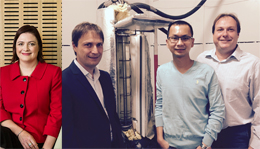27 August 2015
 Two UniSA researchers have collected the nation’s top science awards at last night’s Australian Museum Eureka Prizes.
Two UniSA researchers have collected the nation’s top science awards at last night’s Australian Museum Eureka Prizes.
UniSA’s Deputy Vice Chancellor: Research and Innovation, Professor Tanya Monro, was part of a national team which won the 2015 University of New South Wales Eureka Prize for Excellence in Interdisciplinary Scientific Research, while Associate Professor Frank Bruno led a UniSA team which won the 2015 ANSTO Eureka Prize for Innovative Use of Technology.
Prof Monro’s team, comprising Prof Dayong Jin from the University of Technology Sydney and Macquarie University and Prof Bradley Walsh from Minomic International and Macquarie University, were awarded for their Super Dots research into the ‘world’s smallest, brightest nano-flashlights finding a diseased needle in a haystack’.
The world’s smallest flashlights may be able to light up diseased cells in our bodies. These infected or cancerous cells may be hiding among millions of healthy cells. The Super Dots team has created tiny crystals that can be implanted in the body to reveal the dangerous needle in a haystack.
The team has developed fluorescing nanocrystals that switch on at different times, shining an intense, short burst of light – just tens of millionths of a second – that can reveal any diseased cells.
This research will ultimately allow real-time diagnosis of disease, as well as having potential for creating invisible, lifetime-coded inks that could add uncrackable security to banknotes and passports.
Assoc Prof Bruno and his UniSA colleagues Dr Martin Belusko and Dr Steven Tay were awarded for their work in ‘freezing salt to store solar power’.
The team developed a new phase-change system that provides energy storage at up to a tenth of the cost of batteries. By solidifying and melting an inexpensive liquid salt solution, energy can be stored and released quickly and cheaply.
As well as extending the potential reach of renewable energy, the system also allows Australian produce companies to reduce multibillion-dollar refrigeration electricity costs by ‘charging’ the system (freezing the solution) during inexpensive off-peak hours and ‘discharging’ (melting) during expensive peak hours. The phase-change system resolves the mismatch between generation hours and electricity use, so that solar and wind power can form an even larger slice of the national generation grid.
The Australian Museum Eureka Prizes are the most comprehensive national science awards, honouring excellence in Research and Innovation, Leadership, Science Communication and Journalism, and School Science.
Media contact: Kelly Stone office 8302 0963 mobile 0417 861 832 email Kelly.stone@unisa.edu.au




